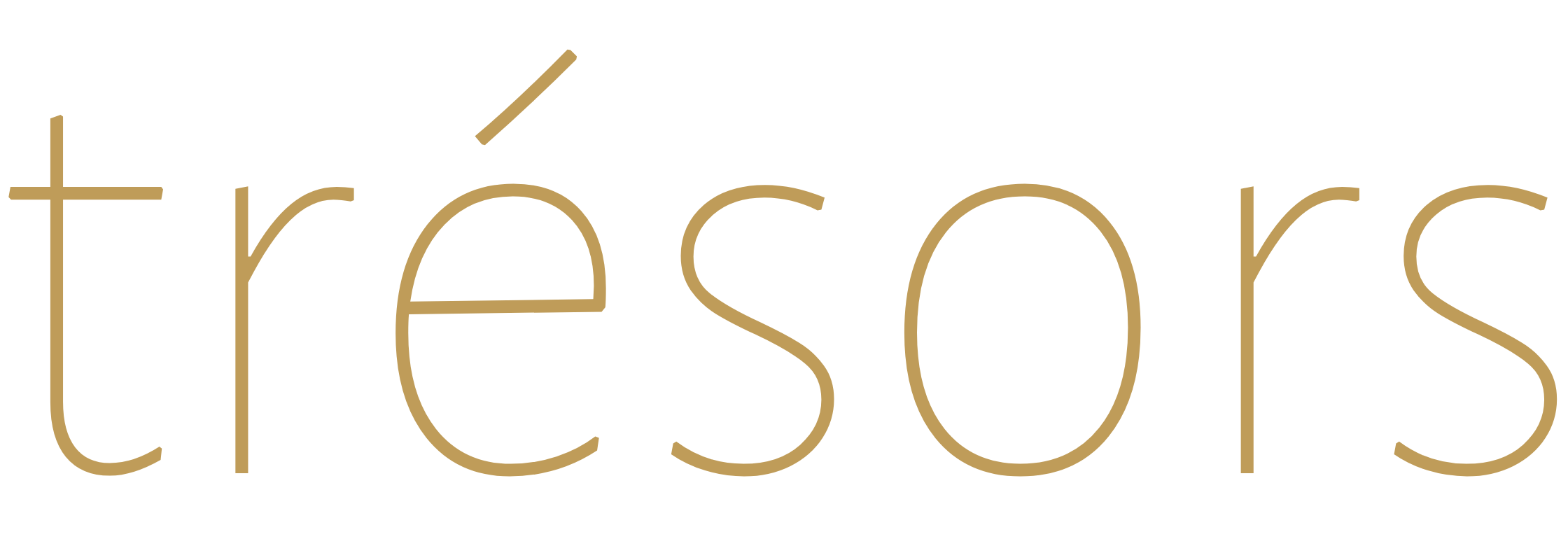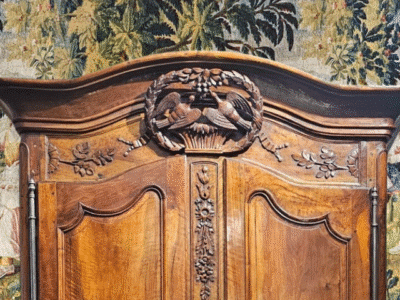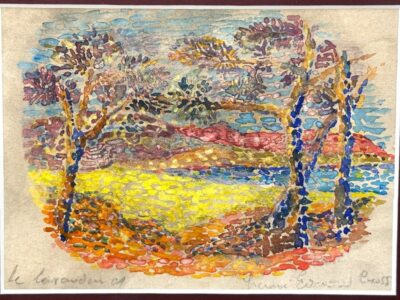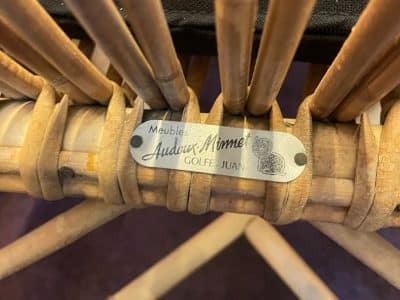Blue like the Mediterranean Sea, the magnificent rococo bed restored in 2010 attracts all the attention when you enter the room. The damascan silk covering the intricately carved mahogany bed frame ripples on the canopy and drapery. The bed is an original Chippendale piece created from a design in “The Gentleman and Cabinet Maker’s Director” published by Chippendale (AKA Chippendale’s Director). It epitomizes the extravagance and luxury of Dumfries House and is a beautiful way to dive into this Scottish stately home.
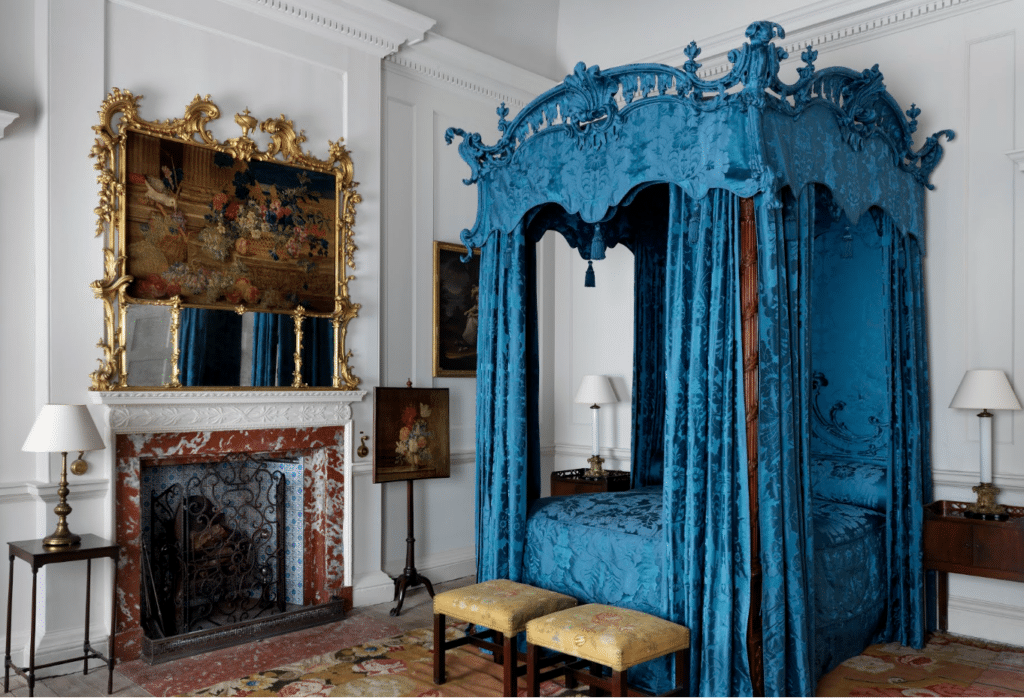
The Best Bed is a Chippendale four-poster bed. The chimney overmantle is also a Chippendale piece showcasing an English knotted carpet attributed to Thomas Moore of London. © Dumfries House
Budding Stars at Work: Robert Adam and Thomas Chippendale
Dumfries House, located in East Ayrshire in the South of Glasgow, was designed by the Adam brothers and hosts an original Chippendale collection. The mansion is a classic association of Palladian architecture with rococo interiors. It still truthfully captures today how the British aristocracy lived in the 18th century during the Georgian era.
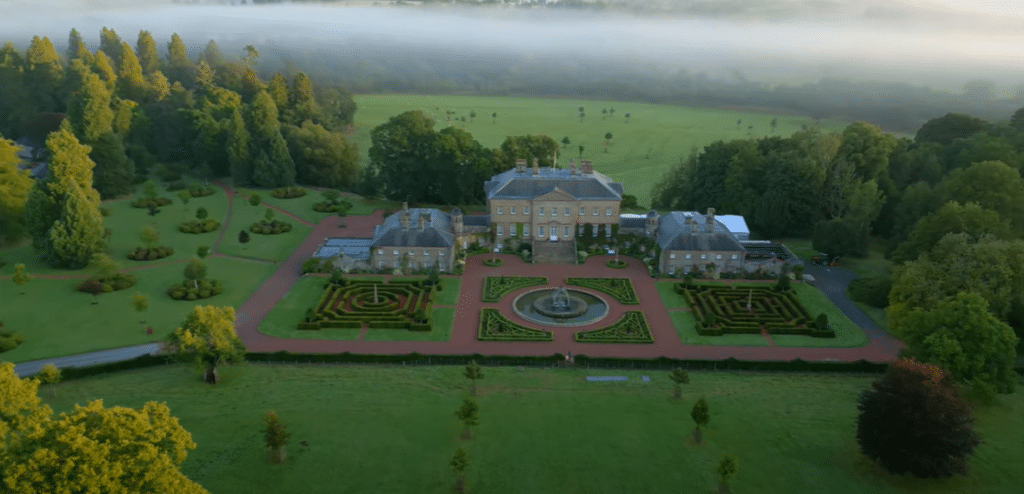
Aerial view of Dumfries House. © Allan Pagaran
In June 2007, Dumfries House, this one-of-a-kind estate was to be sold. The furniture pieces were already labeled, ready to be auctioned as the sale was to take place a few weeks later, when a miraculous turn of events took place. Thanks to the last-minute intervention of the then Prince of Wales (now King Charles III), this architectural jewel of the Scottish Enlightenment was saved from being taken apart. One year later, it opened to the public. Everyone can now enjoy this coherent architectural and interior ensemble and admire the artistry laced in every detail of the house and its decor.
Robert Adam Before His Grand Tour
This country house was commissioned by the 5th Earl of Dumfries, William Crichton Dalrymple (1699-1768), to the Adam brothers’ (John, Robert, and James) architecture firm. Their father William Adam was a prominent Scottish architect and the three sons were following in their father’s footsteps. Dumfries was the first commission they fully completed on their own after their father’s passing in 1748.
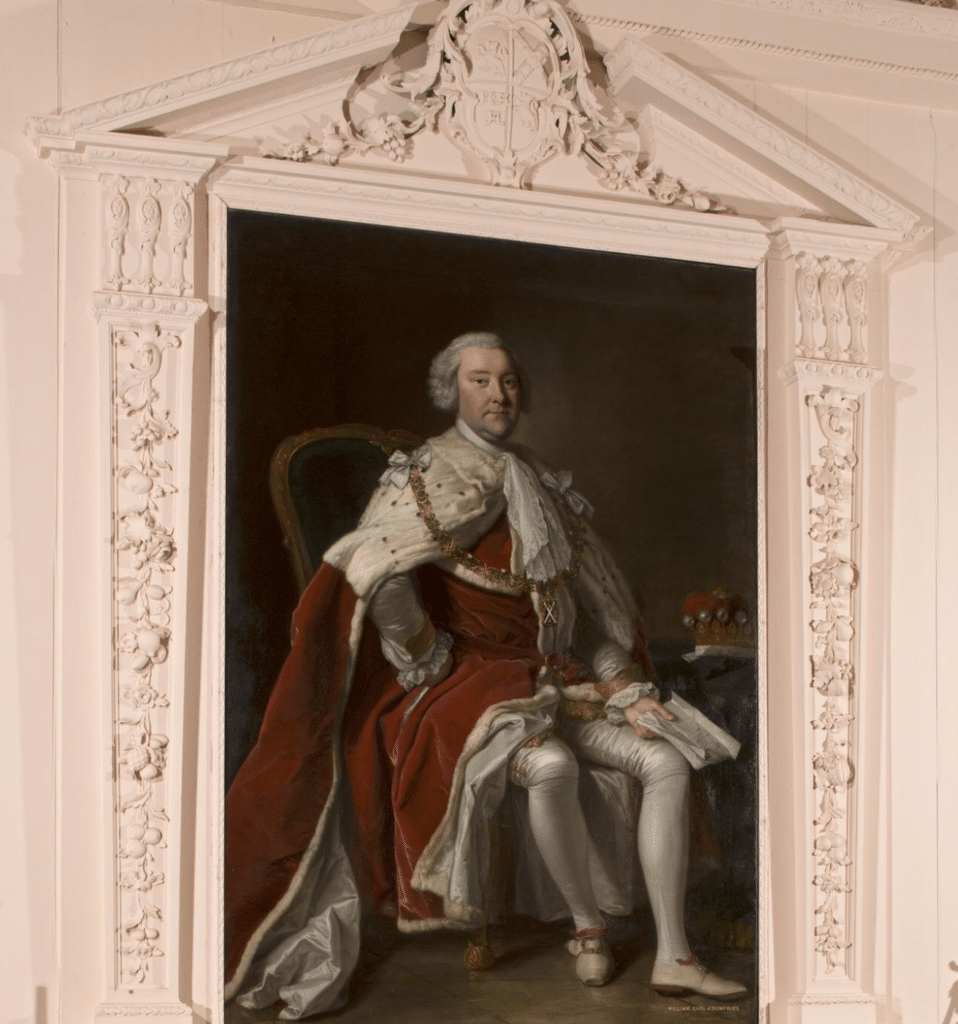
William, Earl of Dumfries. Portrait by Thomas Hudson (1701-1779). The 5th Earl is holding in his hands the contract for Dumfries House. © CANMORE
They designed it in 1754 before Robert went for a Grand Tour in Italy—as James did after him—and rose as the highly fashionable architect he is now known for. Dumfries is unique in this way: it is a genuine early work of the Adam brothers before the influence of their continental voyage and what would later become the ‘Adam style’.

A frontview of Dumfries House in 2023. © David M Clark and licensed for reuse under CC Licence.
Palladian architecture had been all the rage in Great Britain since Inigo Jones (1573-1652) adapted ancient Rome style and Andrea Palladio’s standards. Dumfries House displays the expected classical symmetry. There is no portico, but the monumental central stairs underline the decorated pediment.
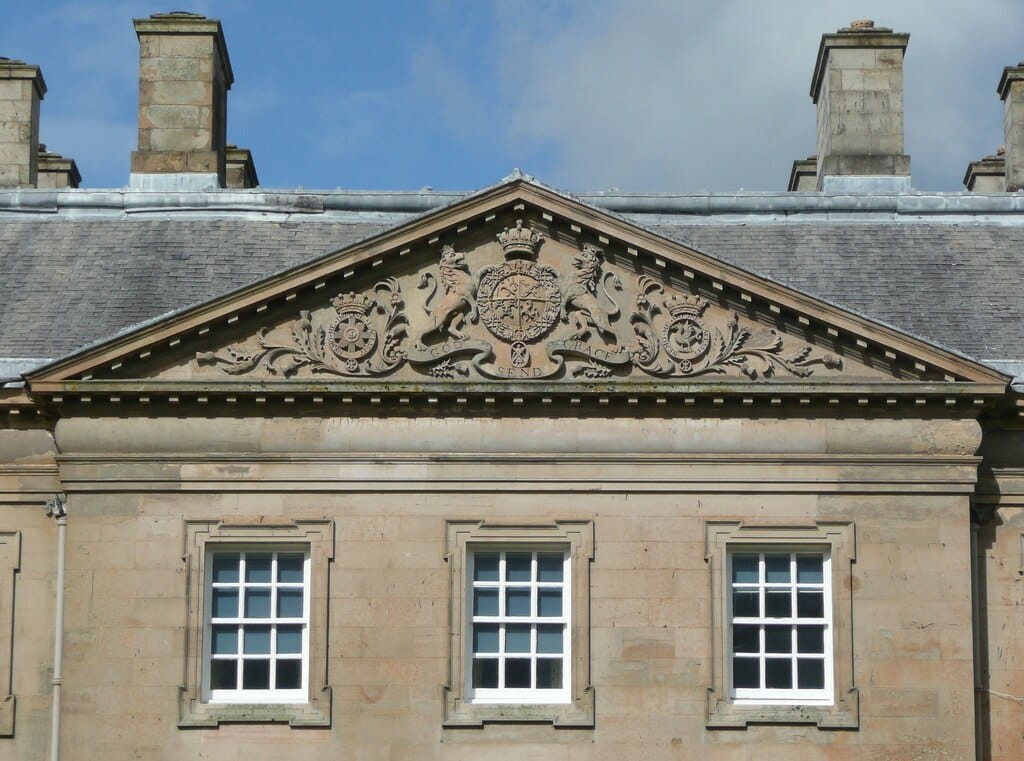
Dumfries House pediment decorated with the coat of arms and Scottish thistles. © Humphrey Bolton and licensed for reuse under CC Licence.
The Adam brothers also applied their design expertise to the Georgian interiors. In the dining room, you can appreciate sophisticated plasterworks influenced by Robert Wood’s drawings in “The Ruins of Palmyra”. Nevertheless, the light pink shade is far more recent as it emerged in the 1950s when this room became the morning drawing room of the Dowager Marchioness of Butte.
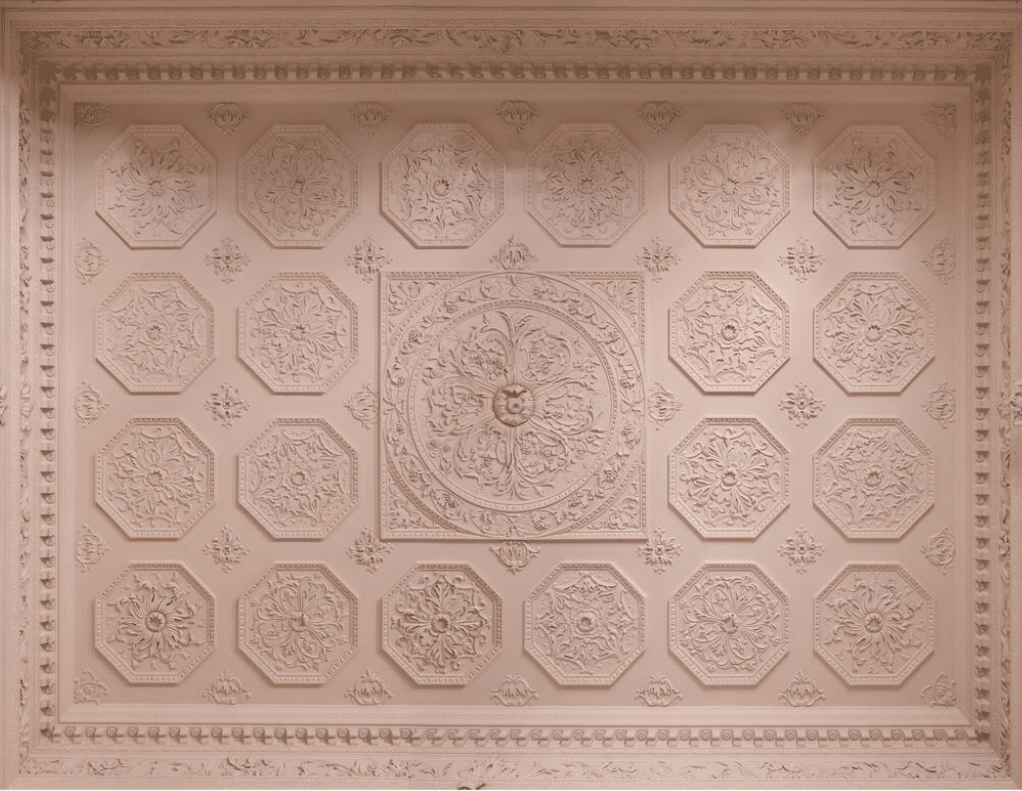
The Pink Dining Room ceiling plasterworks. © CANMORE
Thomas Chippendale Soon After the Publication of “The Director”
The same year the foundation stone of Dumfries House was laid in 1754, Thomas Chippendale (1718-1779) published the first version of his emblematic pattern book “The Gentleman and Cabinet Maker’s Director”. It was an extensive catalog for his time, including 160 designs. It proved to be a stepping stone for the development of his fame internationally long after his lifetime. Over the years, it turned Chippendale into a household name.
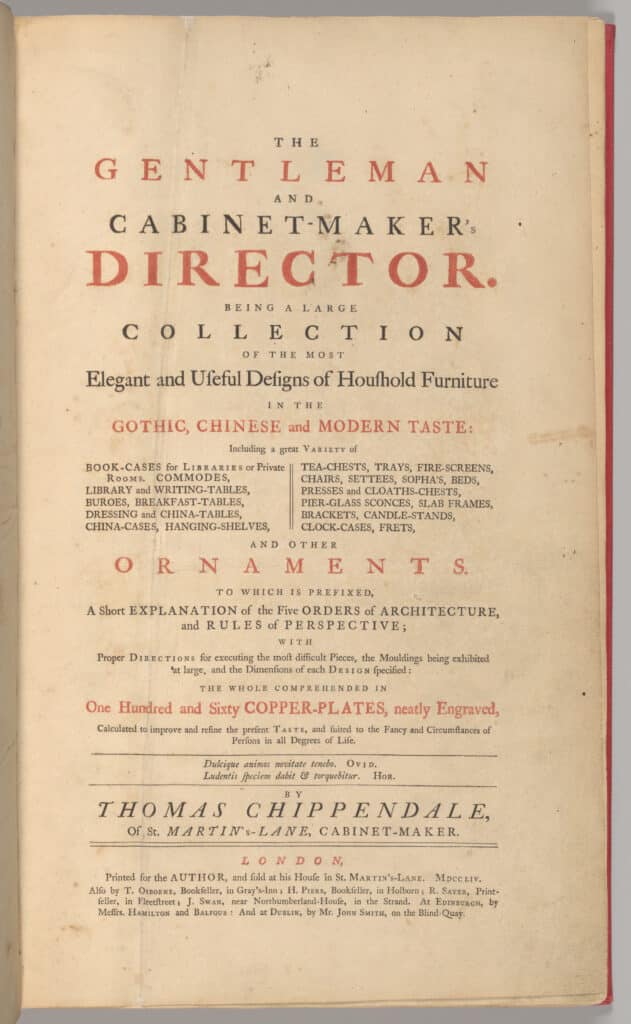
The Gentleman and Cabinet-Maker’s Director by Thomas Chippendale – 1754. Public Domain from The Met.
In 1753, the carpenter had moved to a new larger space in London on 59-61 St. Martin’s Lane. Thanks to his Scottish financing partner John Rannie, he was running The Cabinet and Upholstery Warehouse with about 50 employed craftsmen. It was a clear sign of growing success for Chippendale who was expanding right in the middle of London’s busy carpenter and furniture-making district. Thus, Chippendale was still an up-and-going furniture maker when the 5th Earl of Dumfries decided to trust him with his brand new mansion finished in 1759. He was in his rococo period rich with chinoiseries.
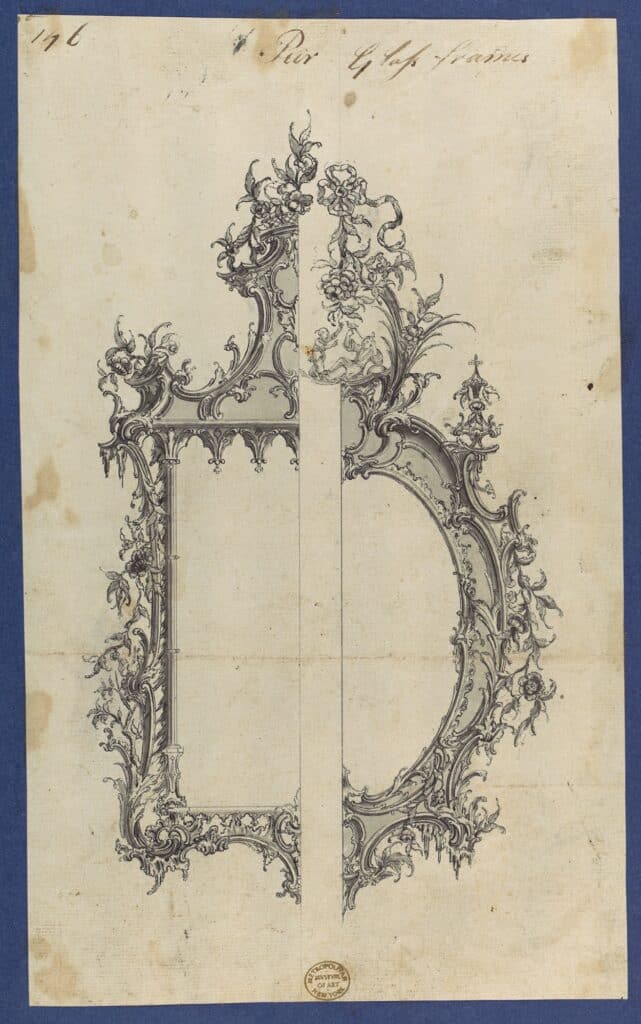
Preparatory drawing of rococo pier glass frames with chinoiseries for Chippendale’s Director. In the 1754 and 1755 editions. Public Domain from The Met.
It is possible that Thomas Chippendale was recommended by Robert Adam. Overall, Adam and Chippendale collaborated on at least 12 projects during their career. The Chippendale furniture at Dumfries House was not custom-made specifically for the property but handpicked from Chippendale’s workshop in London.
An Original Chippendale Collection
There are about 60 pieces created in Chippendale’s workshop in Dumfries House. Let us just focus on some specific outstanding ones today. We already took a glimpse at the four-poster bed and chimney overmantle located in what is now called the Family Bedroom. This bed was the most expensive Chippendale piece acquired by the 5th Earl of Dumfries for this house.
Another jewel in the crown of this Chippendale collection is the bookcase in the Blue Drawing Room. As expressed by the Curator Emeritus Charlotte Rostek: “It’s the House’s most complex piece, both technically and in terms of materials used and the various skills applied: glazing, carving, in-laying, joinery…” If the Christie’s sale had taken place in 2007, it would most probably have gone for over £10 million, maybe even around £20 million.
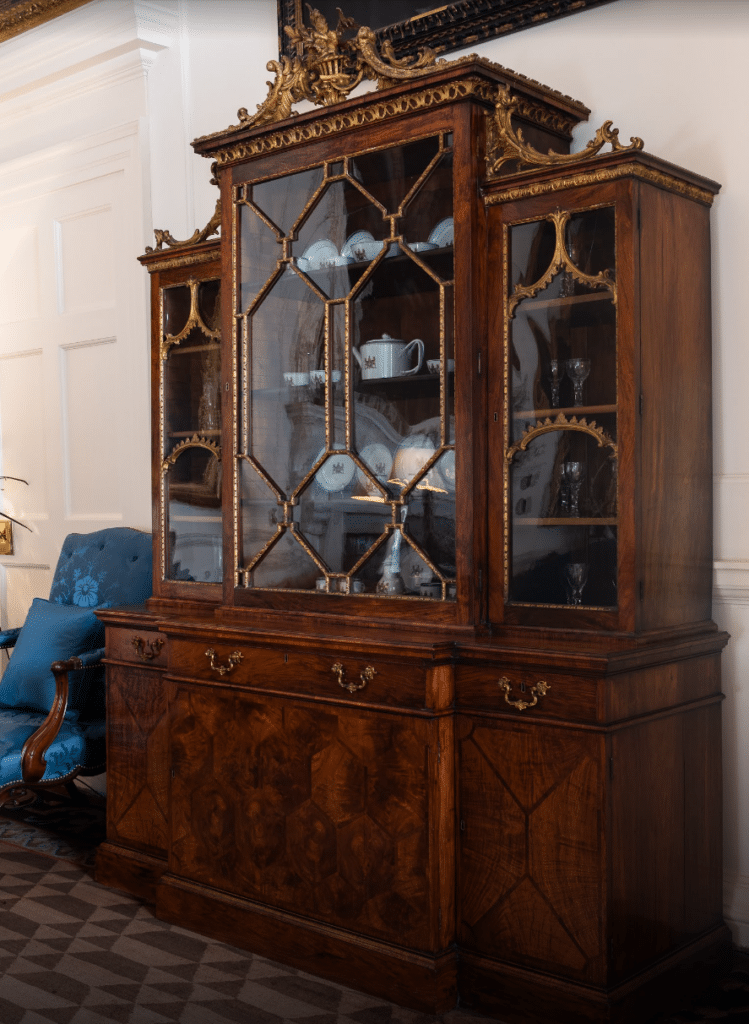
Chippendale bookcase with expressive rococo carving. © Dumfries House
In the Family Parlour, you can enjoy a set of mahogany elbow chairs with acanthus ornating the scrolled arms and feet. The graceful card tables complement them in perfect harmony. As a skilled interior designer of his time, Thomas Chippendale also provided the late George II window cornices and pier glasses. The mirror frames were originally painted white. They were gilded in the 19th century.
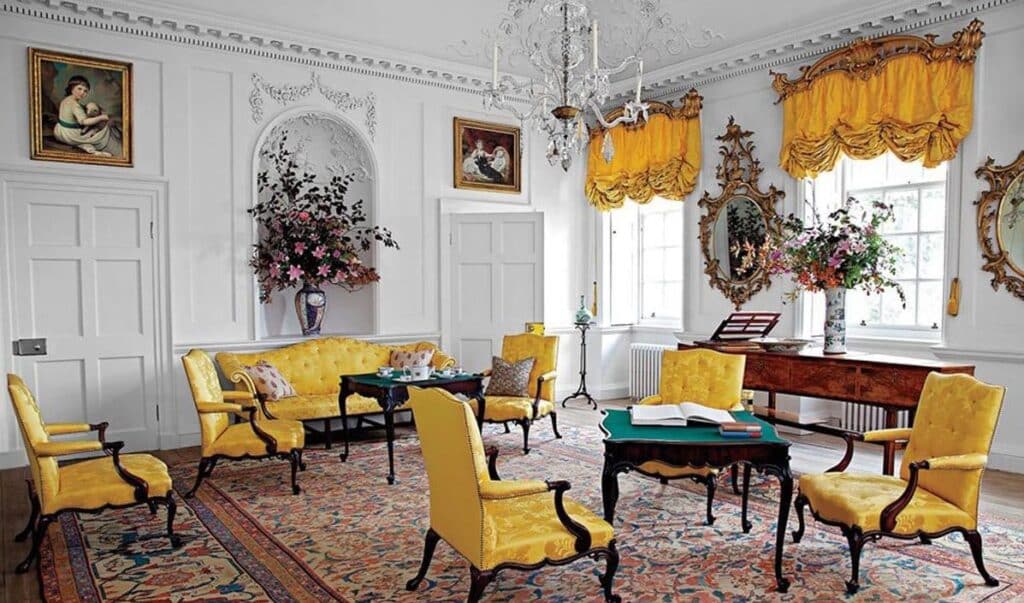
Chippendale chairs, card tables, and decorations in the Family Parlour. © Dumfries House
We cannot but pause too on a distinctive library desk (in mahogany, you likely had guessed) with an ingenuous extendable and adjustable writing surface to be used when standing up. Standing desks have been incredibly popular for the last ten years, but designing functional and adaptable furniture is clearly not a new concept.
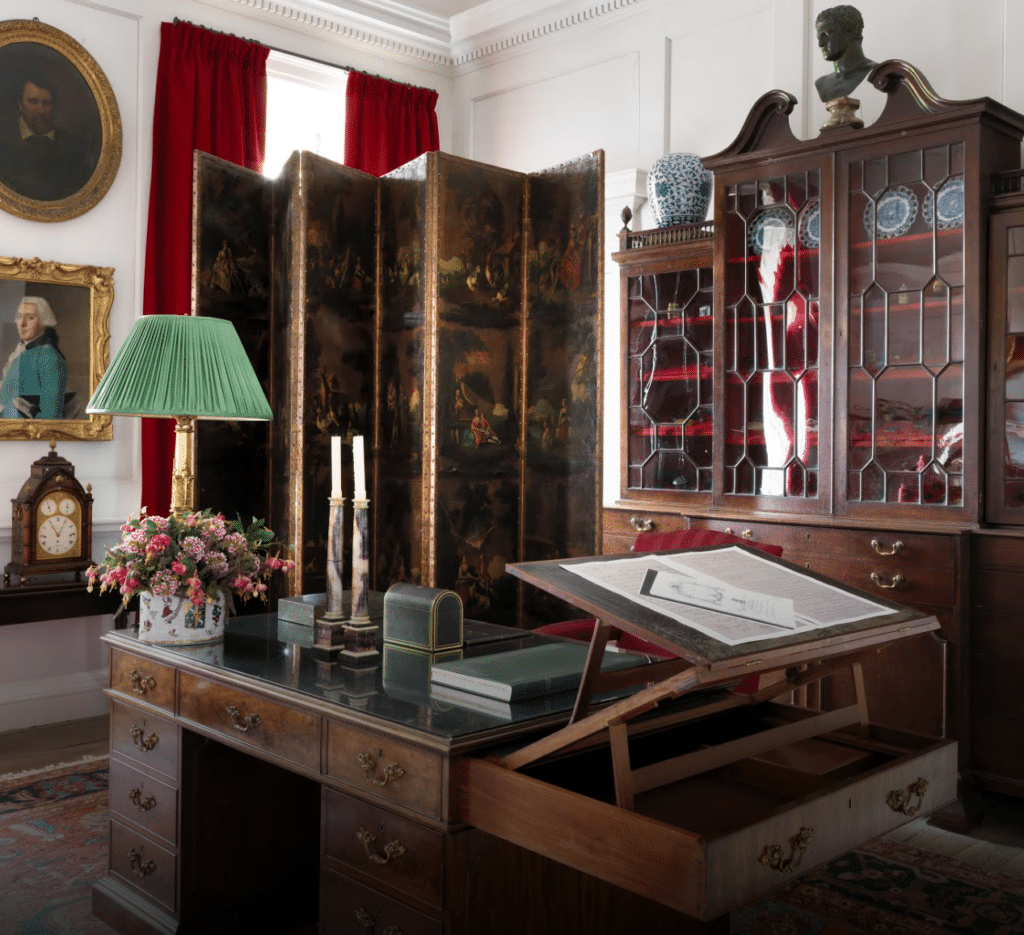
An ingenuous Chippendale desk with an adjustable writing extension. © Dumfries House
Commissioned Scottish Furniture Makers
On top of furniture made by Chippendale, Dumfries House boasts an unrivaled collection of 18th-century furniture commissioned from Scottish wrights who worked in Edinburgh.
Alexander Peter (1713-1772) was an accomplished cabinet-maker and wright who had previously worked with the Adam brothers’ father, William Adam. His involvement with Dumfries took place in 1759-1764 and is his largest documented contract ever with over £400. To give a sense of this commission’s magnitude, the Best Bed, the priciest piece ordered from Thomas Chippendale, cost about £91. We can also measure the fame of Chippendale then as “The Director” was a notable source of inspiration for Peter, e.g. the mahogany chairs, the dining tables, and the sideboard in the dining room or the camelback sofa in the Family Parlour. In a different fashion, Peter made the mahogany Georgian sgabello chairs in the entrance hall.
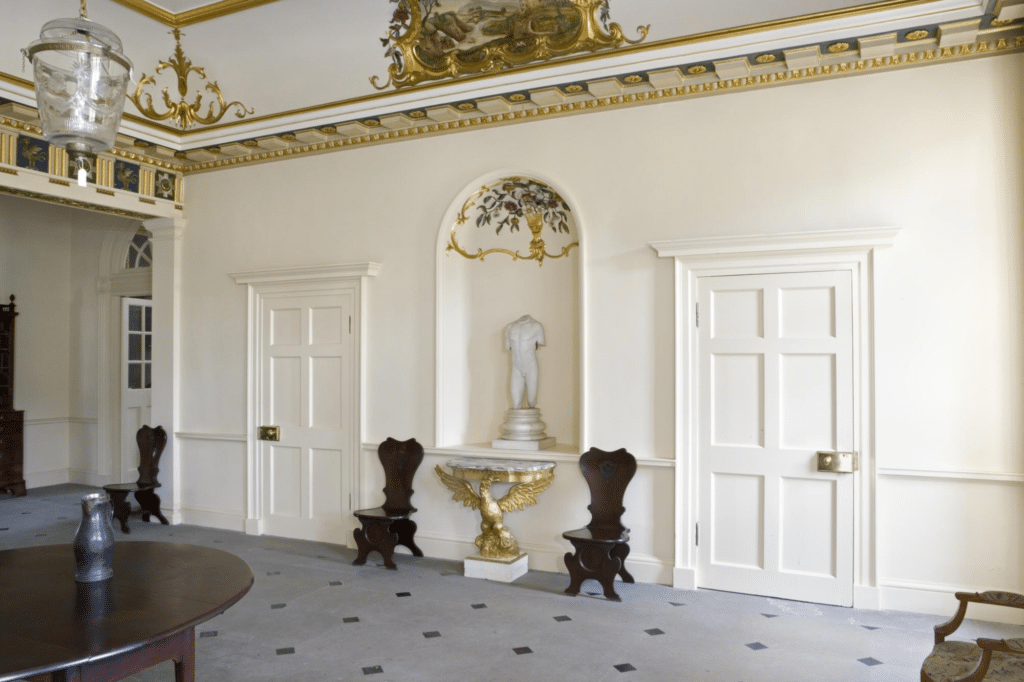
The entrance hall in 2007. With Alexander Peter’s sgabello chairs and Francis Brodie’s eagle table. © CANMORE
William Mathie (1733-1763) was an apprentice of Alexander Peter for a long period while he also had his own carving business. He was essentially a skilled carver expert at intricate rococo patterns whether they be Chippendale or not. For instance, he made the frame for the Jacopo Bassano Renaissance painting in the dining room and two pairs of pier glasses (one in the Blue Drawing Room and one in the Pink Dining Room).
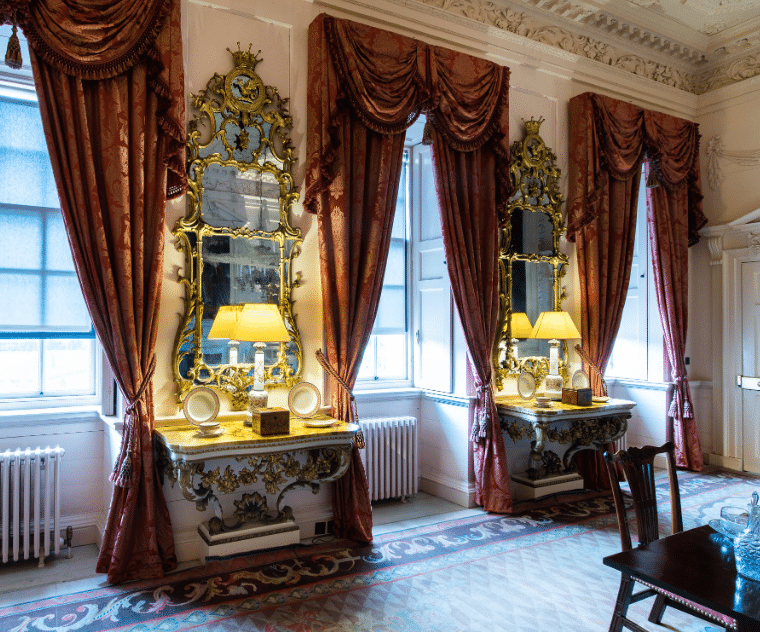
William Mathie’s pier glasses in the Pink Dining Room. They celebrate the 5th Earl’s elevation to the Order of the Thistle Knighthood © Dumfries House
Francis Brodie (1708-1782) was a direct competitor of Alexander Peter. For a wright, he had an unconventional use of Palladio’s head in his brand identity. A token of his stylistic inclination and a reminder, if need be, of the importance of Palladianism in 18th-century Great Britain. There is ample documentation about Brodie’s customers (an exclusively Scottish clientele) proving how respected and fashionable a cabinetmaker he was. Unfortunately, only a few of his pieces are clearly identified as his own today. It makes his lady’s closet present at Dumfries House all the more valuable. It was described by Christie’s as a ” George II brass-inlaid parcel-gilt padouk cabinet-on-chest delivered in 1753″. Interestingly, the furniture type ‘lady’s closet’ was an Edinburgh invention in the early 18th century described as having a large mirror on the cabinet door.
####
The Georgian riches of Dumfries House are a delight for the eyes and the imagination. Could we bump into the ghost of the 5th Earl of Dumfries inspecting his Chippendale chairs or hard at work on his writing desk? It is quite moving to think that nearly 300 years later, we can enjoy pieces that were selected for this very house. Some furniture even traveled at some point to various other estates of the Crichton-Stuart family, but made it back. Early on, the Earls of Dumfries realized how special their 18th-century collections were and had the will to preserve them. We are fortunate today that The Prince’s Foundation made it possible to keep and conserve these treasures in their original chest for everyone to wonder.
####
Create Your Own 18th-Century Rococo Interior
18th-Century Art & Antiques | Rococo Style | Chippendale Style | Georgian Style | Antique Mirrors | Gilded Wood | 18th-Century Furniture | 18th-Century Seats

